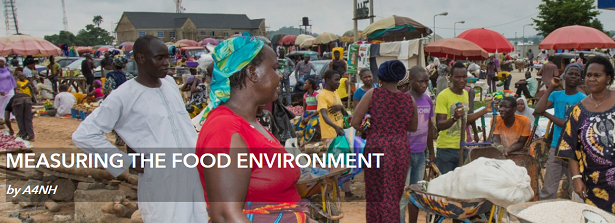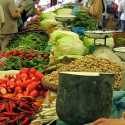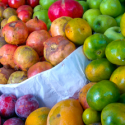Measuring the Food Environment

Food environment research is considered of key importance to deepen the analysis of current national or regional food systems challenges. It is also a basis to identify opportunities for (more) effective interventions by public institutions and market actors. As a follow-up to the food systems consultations held in Ethiopia and Bangladesh, the CGIAR research flagship Food Systems for Healthier Diets (FSHD), led by Wageningen University & Research (WUR) and part of A4NH, hosted a “Food Environment” workshop with CGIAR partners in Ethiopia November, 2019. The workshop aimed to explore the concept of food environment and related research.
The food environment, or where the consumer meets the food to be consumed, is an important element in the food system framework. While it has a significant impact on diets, it is not well understood, compared to other, more well-researched parts of the food system. This is especially the case as it relates to low- and middle-income countries, where food systems are transforming the fastest and the most. Moreover, among those who are studying this topic, a wide variety of indicators and metrics are being used, making harmonization difficult. These indicators tend to be still in a development phase, with very few validated, and often focus on a single food or group of foods, rather than the larger system.
A4NH researchers in the Food Systems for Healthier Diets research flagship set about to bridge this gap in November, with a three-day workshop, held in Addis Ababa, Ethiopia, bringing together nutrition experts from across CGIAR as well as food environment facilitators. Attendees met to explore the role the food environment plays, identify gaps in knowledge, and target ways to work together to move research in this area forward.
Background documents to download
- Read the Food Environment workshop report here.
- Read the workshop Background Note here.
The first two days of the gathering involved the approximately 30 researchers first agreeing upon key characteristics of the food environment using the HLPE (2017) framework as a basis:
- Food availability and physical access
- Food prices and affordability
- Convenience and time savings
- Promotion, advertising, and information
- Quality and safety
They discussed differences including wild versus cultivated, informal versus formal markets, and built environments versus natural ones, agreeing that these characteristics play different roles at each stage of food system transformation. They considered drivers that cut across these issues, and how consumer behavior and individual preferences interact with these components of the food environment.
Yet the question remained: how can researchers shift from focusing on a single food to focusing on the whole diet, in order to inform interventions in the food environment, and ensure they can be monitored and evaluated? The second day enabled the group to dive into the realities of the food environment, with time spent in the field, visiting several markets and supermarkets. There, they tried out methodologies developed by partners, and looked at factors including produce desirability and color, the cost of the recommended diet, and photo documentation. This hands-on experience better informed the discussions that followed, which focused on topics including why CGIAR should focus on the food environment and what priority areas exist; the metrics, methods, and tools available to assess; and what partners need to improve work in this area.
Food Environment Workshop Agenda of Presentations
Day One
- Welcome and introduction: Gina Kennedy and Inge Brouwer
- Food environment typology and food environment transition over time: Shauna Downs
- Metrics and tools in food environment research: Anna Herforth, Djeinam Toure, and Shauna Downs
- Assessing influencing factors in the school food environment using Photovoice: Ursula Trubswasser
- Retail Diversity for Diet Diversity (RD4DD): Gina Kennedy
- Retail Diversity index: Chris Bene
- Fill the nutrient gap: Zebibba Ayenew
- Food environment tools: Selena Ahmed
Day Two
- Priorities for Research: Gina Kennedy and Inge Brouwer
During the following day, Ethiopian stakeholders, members of the Food & Business Knowledge Platform within the Netherlands-CGIAR partnership, academics, development practitioners, and others joined the researchers for a discussion that included an update on food systems work in Ethiopia, an overview of tools related to the food environment, and what is needed from those tools to move research forward. Attendees commented on how tools need to be applicable in more settings, including rural as well as urban, low- and middle-income countries as well as high-income, taking into consideration gender issues, and more.
Moving forward, researchers plan to conduct a policy context review, to understand how food environment issues interact with policy, as well as share experiences more broadly with plans for a webinar and other learning opportunities.
_ _ _
Source: A4NH (CGIAR Research Program on Agriculture for Nutrition and Health – Led by IFPRI)
This workshop took place in the context of the Netherlands – CGIAR Strategic Partnership. To read more about the collaboration between the Netherlands and CGIAR, follow this link.







